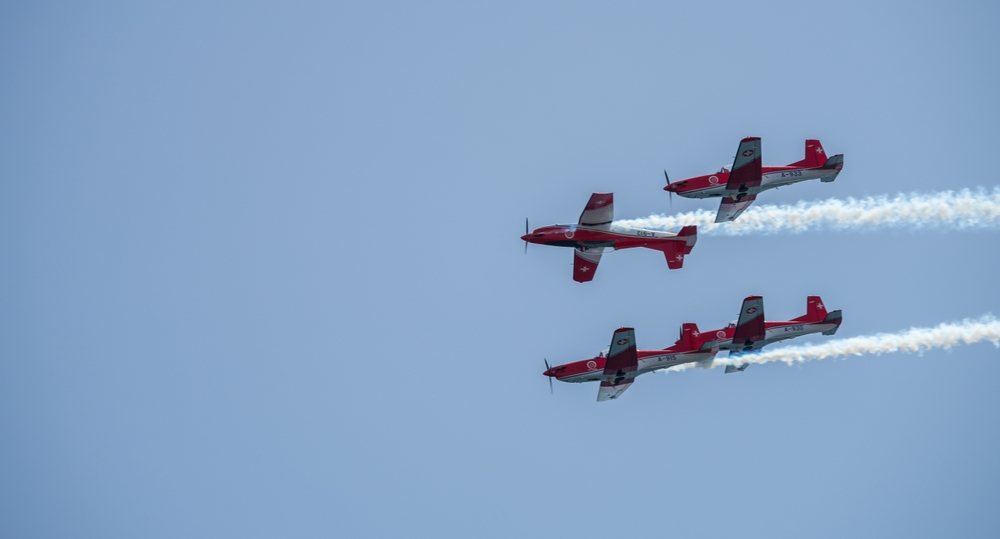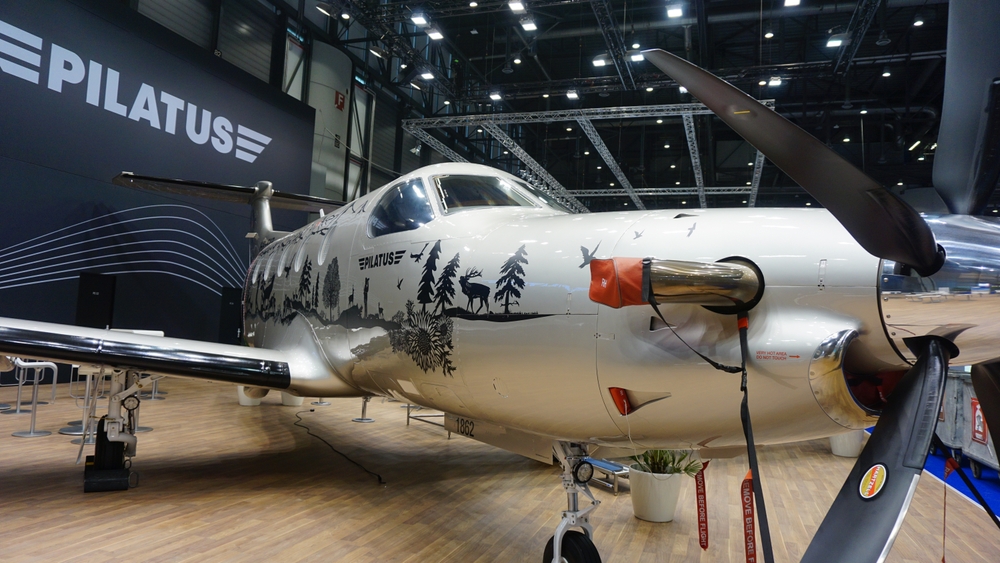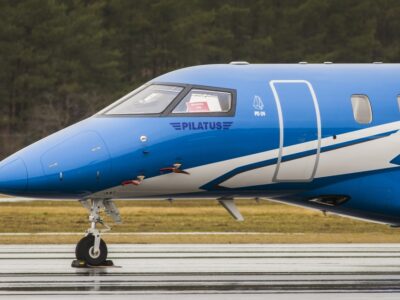Pilatus Aircraft is a privately held corporation that employs more than 1,200 individuals and delivers aircraft and aviation solutions globally. It’s one of the most successful aircraft manufacturers for niche market aircraft that’s especially well-known for its single-engine turboprop aircraft.
Three divisions are responsible for running Pilatus’s day-to-day activities, such as maintenance and subcontracting:
- General aviation
- Civil aviation
- Education and training, special missions
Pilatus Business Aircraft is a completely owned subsidiary of Pilatus Aircraft that was established in 1996 and is headquartered in Broomfield, Colorado. The company offers completions, promotion, distribution, and support for Pilatus aircraft throughout North and South America.
Pilatus Australia, which has its headquarters in Adelaide and was founded in 1998 as a sales support center, is the company’s second subsidiary. It’s in charge of promoting the PC-12 and the PC-24 in Australia, New Zealand, Papua New Guinea, and the Pacific Islands.
Topics
About the Company
- 1939 – The company was founded by Emil Georg Bührle. Their initial projects were maintenance and repair services for the Swiss Air Force.
- 1942 – Under a contract with the Swiss military, Pilatus started modifying 33 EKW C-3603. The same year the construction of the two-seat trainer P-2 began.
- 1944 – The construction of the Pilatus SB-2 Pelican was finalized, and a prototype for a single-engined light transport was created, named the P-4.
- 1959 – The Pilatus Porter PC-6 was created. Because of the PC-6’s exceptional capability of flying on short and unimproved runways, it was frequently employed in place of choppers in specific situations. It was popular all across the world.
- 1966 – The PC-7, a turboprop-powered derivative of the P-3, had its first flight, but unsuccessfully. The plane went in flames, and the company halted the research until the 1970s.
- 1970 – Pilatus’s model B-4 was updated to simplify production and renamed the B-4/PC-11.
- 1972 – The PC-11 had its maiden flight, and the firm produced 300 of them.
- 1975 – Pilatus developed a new prototype, the PC-7 Turbo Trainer, and put it on the market.
- 1979 – The company acquired Britten-Norman, another aircraft manufacturer and service provider.
- 1982 – An enhanced version of the PC-7 was created, and four years later, unveiled to the public as the PC-9.
- 1987 – Pilatus PC-12 was born, which led to the construction of the PC-12 Eagle surveillance aircraft in 1995, and the PC-12 Spectre. Both models were adopted by the United States Air Force and renamed U-28A.
- 1997 – Pilatus acquired TSA Transairco, Geneva.
- 1998 – Britten-Norman was sold. The same year Pilatus Australia was formed.
- 2000 – Pilatus was sold to a group of Swiss investors by its previous owners.
- 2002 – The turboprop PC-21 was designed.
- 2013 – Pilatus Aircraft Industry (China) was established with the intention of manufacturing PC-6 and PC-12 aircraft in Chongqing.
- 2013 – The PC-24 was developed in response to comments made by PC-12 customers.
- 2014 – The HB-VXA aircraft was rolled off the assembly line for the first time.
By purchasing Skytech, a company that specializes in aircraft sales and repair, the Swiss executive aircraft maker Pilatus Aircraft is further strengthening its foothold in the American market. Skytech was established in 1976 and had two sites on the East Coast, in Baltimore, Maryland, and Rock Hill, South Carolina. Since 1993, Skytech has been an accredited distribution and repair facility for Pilatus aircraft. The firm will continue to function as an independent enterprise under the Skytech trademark, responsible for maintaining and selling PC-12 and 24 on the East Coast, plus aircraft from other brands.
Products and Services
Pilatus has had a brand new structural assembly hall since 2019 at their corporate headquarters in Stans, Switzerland – Hall S. The new Hall S increased the manufacturing space by 118,400 square feet. The primary focus of production in Hall S is the PC-24 and all of the procedures necessary for the independent fabrication of aircraft airframes.
In the yearly study conducted by Professional Pilot Magazine, Pilatus customer support services have been rated as one of the finest in the industry 19 years in a row.
Aircraft Types

- The SB-2 Pelican, the company’s first plane, was designed in the 40s.
- The turning point came in 1959 with the piston propeller PC-6 Porter.
- Pilatus made an update to PC-6 Porter to turboprop engines, managing to stay in manufacturing production till 2019.
- After the popularity of the PC-6, a bigger turboprop called PC-12 was unveiled in 1989 and delivered in 1994.
- The firm entered the business jet industry by introducing the Pilatus PC-24, a twin-engine in the light jet category.
Because 90 percent of the Pilatus airplanes are placed on the worldwide market, the company must comply with a complex set of trade regulations that mandate the use of specific components that are manufactured in other countries. For instance, Pilatus can ship to the American market thanks to the onboard computers supplied by the American company Honeywell.
The following is an overview of all of the aircraft that have been manufactured by Pilatus Aircraft:
- Pilatus SB-2 Pelican
- The Pilatus P-1 was a proposal for a single-seat trainer that was made in 1941 but was never constructed.
- Pilatus P-2 – 1942
- Pilatus P-3 – 1953
- Pilatus P-4 – 1948
- The Pilatus P-5 was intended to be an artillery observation aircraft, but it was never constructed.
- Pilatus PC-6 Porter – 1959
- Pilatus PC-7 – 1966
- Pilatus PC-8D, The Twin Porter, was a twin-engined variation of the PC-6 that was only ever built as a prototype in 1967.
- Pilatus PC-9 – 1984
- The Pilatus PC-10 was a proposed twin-engined transport aircraft under development in 1970.
- Pilatus PC-11/Pilatus B-4 – 1972
- Pilatus PC-12 – 1991
- Pilatus PC-21 – 2001
- Pilatus PC-24 – a twin-engined jet
Let’s review some specific models.
The PC-7 Mk II
The PC-7 Mk II is a small turboprop learner aircraft that began production in 1994. Some standard features of the PC-7 include ejection seats and cutting-edge electronics. There are currently more than 150 PC-7 Mk IIs in operation across six nations, as well as in the Indian Air Force, which at the moment is responsible for the upkeep of a fleet of 75 aircraft.
Pilatus PC-6
The Pilatus PC-6 was first created as a piston-powered utility aircraft in the late 1950s; however, the present version is powered by a single turboprop engine and incorporates a modern glass cockpit. The PC-6 is more than just a dependable and versatile utility aircraft; it also has exceptional short takeoff and landing capabilities (STOL), endurance, and adaptability in all weather and ground situations. Clients can rearrange the interior to accommodate up to ten passengers or over two thousand pounds of freight.
Over 600 PC-6 planes have been manufactured and delivered to customers, capping a production run of over sixty years. Pilatus ceased production of the PC-6 in 2017 in order to put more of its resources into developing its other aircraft.
Pilatus PC-12– a twin-engined jet
Over 1,600 Pilatus PC-12 aircraft have been manufactured so far, making it Pilatus’s number-one turboprop airplane with one 1,200 horsepower engine. The PC-12 NG is the most recent iteration of this model.
Pilatus PC-12 possesses a roomy pressurized cabin, affordable operating expenses, and the capability to perform on grassland and other types of rough terrain. As a result of the aircraft’s adaptability, the PC-12 is popular for use as a mode of transportation for both passengers and freight, as an ambulance service, and for employment in various special assignments.
After ten years of usage, the Pilatus PC-12 maintains up to 85% of its value, significantly surpassing the value retained by comparable turboprops or business jets. It sells 40% faster than all the other pre-owned private jets.
The PC-21
The PC-21 is a sophisticated twin-seat turboprop training aircraft that’s powered by a single engine that generates 1,600 horsepower. Along with the PC-21, Pilatus has also created a seamlessly engaged training system to complement it. This system includes the most up-to-date simulators and pilot instructional methods.
Most Famous Aircraft by the Company
Pilatus PC-24 – a twin-engined jet
Two Williams turbofan engines power the PC-24, each capable of producing more than 3,200 pounds of power. This aircraft can accommodate six to eight passengers when fitted for executive transportation, but it can accommodate up to ten passengers when used for regular transit.
There are seven different configuration options available for the aircraft, including:
- Commuter
- Executive
- Medevac
- Combi
- Two quick-change layout options
- Special mission
The only weakness is that it has a top cruising speed of 425 knots, slower than its rivals. It can take off and land on short, long, paved, or rough runways, and has a roomy aft freight section and an easily reconfigurable cabin. Because the cargo door is so broad—4 feet to be exact—it is convenient for medevac operations and cargo transit.
Safety
At Pilatus, safety is always put ahead of other priorities.
Pilatus currently possesses accreditations that help to ensure their outstanding reputation in the industry. These certifications are:
- ISO 9001 certification that addresses quality management systems in the aviation sector;
- EN/AS 9100, which is the highest certification that can be achieved by a company that specializes in the worldwide aviation manufacturing business.
Sustainability

The firm has been awarded the ISO 14001 certification for initiatives that contribute towards a safer environment.
Moreover, Pilatus is among the most significant employers in the region of Central Switzerland, with more than 2,000 people working at its headquarters alone. Job education for younger generations has long been one of Pilatus’ top priorities. The company currently offers apprenticeships in 14 different fields to 140 aspiring professionals.
Innovations
The Pilatus Research and Development unit is the creative hub of the Pilatus company. This very talented group of over 300 professionals is responsible for the maintenance of the existing fleet as well as the design and development of the upcoming aircraft.
In order to tackle this task, their experts make use of cutting-edge aerospace engineering techniques, such as:
- digital mock-up computational fluid dynamics
- CAX (computer-aided technologies)
- PDM (product data management)
- flight simulation
- structural dynamic analysis
- 3D printing
- virtual avionics prototyping systems
The Design Organisation Approval department specializes in organization and is responsible for overseeing the entirety of the following operations:
- the process of developing new types of aircraft
- beginning with the preliminary study of the concept and continuing through the design
- prototype and flight test
- certification phases
- handing the project off to Pilatus production
The European Aviation Safety Agency (EASA) permits Pilatus to carry out a wide variety of certification procedures for newly manufactured aircraft, aviation systems, and aircraft parts.
The Pilatus manufacturing department is working on a diverse set of core strengths that allow them to produce the majority of their components, including:
- production of high-end carbon fiber elements
- multifaceted cutting tools
- sheet metal working
This improves the communication and coordination between manufacturing and design, resulting in complete services that are precisely customized to fit the customer’s specific needs. In addition to the production of components for use in Pilatus aircraft, the Manufacturing section is also responsible for developing cutting-edge solutions for third-party customers.
Conclusion
Somewhere at the bottom of the Swiss Alps is Stans, Switzerland, which serves as the headquarters for Pilatus. The Alpine environment has played an essential role in developing the company’s business and competitive capabilities, bringing a tradition of durable, adaptable aircraft that pilots can fly in the harshest environments.
For decades, the company has focused only on the turboprop portion of the market. For a successful producer of turboprop aircraft, expanding into the market for business jets could appear to be the next logical step; yet, this would be a dangerous move due to the substantial investment necessary and the industry’s increasing complexity. The company’s foray into the market for business aircraft has thus far been quite beneficial for the firm.
Pilatus’s mission is to do everything possible to ensure that a national aircraft legacy, “Swiss Made,” is preserved for future generations as a combination of cutting-edge technology with precise handiwork.

